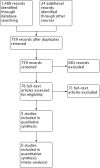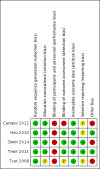Mobile phone-based interventions for improving contraception use
- PMID: 26115146
- PMCID: PMC6485989
- DOI: 10.1002/14651858.CD011159.pub2
Mobile phone-based interventions for improving contraception use
Update in
-
Mobile phone-based interventions for improving contraception use.Cochrane Database Syst Rev. 2023 Jul 17;7(7):CD011159. doi: 10.1002/14651858.CD011159.pub3. Cochrane Database Syst Rev. 2023. PMID: 37458240 Free PMC article.
Abstract
Background: Contraception provides significant benefits for women's and children's health, yet an estimated 225 million women had an unmet need for modern contraceptive methods in 2014. Interventions delivered by mobile phone have been demonstrated to be effective in other health areas, but their effects on use of contraception have not been established.
Objectives: To assess the effects of mobile phone-based interventions for improving contraception use.
Search methods: We searched for randomised controlled trials (RCTs) of client-provider interventions delivered by mobile phone to improve contraception use compared with standard care or another intervention. We searched the electronic databases Cochrane Central Register of Controlled Trials (CENTRAL), MEDLINE, EMBASE, Global Health, PsycINFO, POPLINE, Africa-Wide Information and Latin American Caribbean Health Sciences Literature (LILACS) from January 1993 to October 2014, as well as clinical trials registries, online mHealth resources and abstracts from key conferences.
Selection criteria: Randomised controlled trials of mobile phone-based interventions to improve any form of contraception use amongst users or potential users of contraception. Outcome measures included uptake of contraception, measures of adherence, pregnancy and abortion.
Data collection and analysis: Two review authors independently screened titles and abstracts of studies retrieved using the search strategy and extracted data from the included studies. We calculated the Mantel-Haenszel risk ratio (RR) for dichotomous outcomes and the mean difference (MD) for continuous outcomes, together with 95% confidence intervals (CIs). Differences in interventions and outcome measures did not permit us to undertake meta-analysis.
Main results: Five RCTs met our inclusion criteria. Three trials aimed to improve adherence to a specific method of contraception amongst existing or new contraception users by comparing automated text message interventions versus standard care. Two trials aimed to improve both uptake and adherence, not limited to one method, in both users and non-users of contraception. No trials were at low risk of bias in all areas assessed.One trial in the USA reported improved self reported oral contraceptive (OC) continuation at six months from an intervention comprising a range of uni-directional and interactive text messages (RR 1.19, 95% CI 1.05 to 1.35). One trial in Cambodia reported increased self reported use of effective contraception at four months post abortion from an intervention comprising automated interactive voice messages and phone counsellor support (RR 1.39, 95% CI 1.17 to 1.66).One feasibility trial in the USA reported a lower mean number of days between scheduled and completed attendance for the first but not subsequent Depo-Provera appointments using clinic records from an intervention comprising reminders and healthy self management text messages (mean difference (MD) -8.60 days, 95% CI -16.74 to -0.46). Simple text message OC reminders had no effect on missed pills as assessed by electronic medication monitoring in a small trial in the USA (MD 0.5 missed pills, 95% CI -1.08 to 2.08). No effect on self reported contraception use was noted amongst isotretinoin users from an intervention that provided health information via two uni-directional text messages and mail (RR 1.26, 95% CI 0.84 to 1.89). One trial assessed potential adverse effects of the intervention and reported no evidence of road traffic accidents or domestic abuse.
Authors' conclusions: Our review provides limited evidence that interventions delivered by mobile phone can improve contraception use. Whilst evidence suggests that a series of interactive voice messages and counsellor support can improve post-abortion contraception, and that a mixture of uni-directional and interactive daily educational text messages can improve OC adherence, the cost-effectiveness and long-term effects of these interventions remain unknown. Further high-quality trials are required to robustly establish the effects of interventions delivered by mobile phone to improve contraception use.
Conflict of interest statement
None known.
Figures


























References
References to studies included in this review
Castano 2012 {published data only}
Hou 2010 {published data only}
Smith 2014 {unpublished data only}
Trent 2013 {published and unpublished data}
-
- Trent M, Tomaszewski K. Family planning appointment attendance among urban youth: results from the depotext trial. Journal of Adolescent Health 2013;52(2):S88. [DOI: ]
References to studies excluded from this review
Bannink 2014 {published data only}
-
- Bannink R, Broeren S, Joosten‐van Zwanenburg E, As E, Looij‐Jansen P, Raat H. Effectiveness of a web‐based tailored intervention (E‐health4Uth) and consultation to promote adolescents' health: randomized controlled trial. Journal of Medical Internet Research 2014;16(5):e143. [DOI: 10.2196/jmir.3163] - DOI - PMC - PubMed
Berenson 2012 {published data only}
Bracken 2014 {published data only}
Constant 2014 {published data only (unpublished sought but not used)}
Gold 2011 {published data only}
Hall 2013 {published data only}
Juzang 2011 {published data only}
Kaoaiem 2012 {published data only}
-
- Kaoaiem H. The effect of squad leader mentors through short message services for mobile phones in promoting safe sex among first (central) army area conscripts of Thailand. Journal of the Medical Association of Thailand 2012;95(2):249‐56. [PUBMED: 22435256] - PubMed
Katz 2011 {published data only}
Kirby 2010 {published data only}
L'Engle 2013 {published data only}
Lim 2012 {published data only}
Mackenzie 2009 {published data only}
-
- Mackenzie H. A text messaging trial in family planning clinics. Studies in Health Technology and Informatics 2009;146:154‐9. [PUBMED: 19592826] - PubMed
O'Sullivan 2008 {published data only}
-
- O'Sullivan G. The Saathiya trusted partner program in India: meeting young couples' reproductive health needs. Social Marketing Quarterly 2008;14(3):109‐20. [DOI: 10.1080/15245000802261324] - DOI
Sridhar 2013 {published data only}
-
- Sridhar A, Chen A, Glik D. Plan a birth control: randomized controlled trial of a mobile health application. Abstracts / Contraception 2013;88:463. [DOI: 10.1016/j.contraception.2013.05.125] - DOI
Suffoletto 2013 {published data only}
Walakira 2013 {published data only}
-
- Walakira B, Lubaale Y, Balidawa F, Nalule S, Githinji F. Can mobile phone text messaging increase uptake of family planning services in Uganda?. Measure Evaluation 2013. [http://www.cpc.unc.edu/measure/publications/wp‐13‐135]
References to ongoing studies
Johnson 2014 {unpublished data only}
-
- Johnson D, Riley P, Juras R, Choi S, L'Engle K, Okello F. m4RH impact evaluation. Presentation at the Global mHealth forum: http://www.mhealthsummit.org/globalmhealthforum. Washington DC, 2014.
NCT01401816 {published data only}
-
- NCT01401816. Advanced provision of emergency contraception: utilizing technology to increase prescription fill rates. clinicaltrials.gov/show/NCT01401816 (accessed 9 October 2014).
NCT01545609 {published data only}
-
- NCT01545609. A trial assessing the effectiveness of text messages in improving continuation of birth control (BC 2U). clinicaltrials.gov/ct2/show/NCT01545609 (accessed 22 Jan 2015).
NCT02093884 {published data only}
-
- NCT02093884. A pilot study using text messaging to communicate with adolescent females in the pediatric emergency department (T2I). clinicaltrials.gov/ct2/show/NCT02093884 (accessed 9 October 2014).
Additional references
Abraham 2008
-
- Abraham C, Michie S. A taxonomy of behavior change techniques used in interventions. Health Psychology 2008;27(3):379‐87. - PubMed
Ali 2010
-
- Ali M, Cleland J. Contraceptive switching after method‐related discontinuation: levels and differentials. Studies in Family Planning 2010;41(2):129‐33. - PubMed
Bastawrous 2012
Bradley 2009
-
- Bradley S, Schwandt H, Khan S. Levels, trends, and reasons for contraceptive discontinuation. DHS Analytical studies 20: Measure DHS; 2009 Sept. Publication ID: AS20.
Bullen 2013
-
- Bullen P. Operational challenges in the Cambodian mHealth revolution. Journal of Mobile Technology in Medicine 2013;2(2):20‐3.
Car 2012
CDC 2015
-
- Centers for Disease Control and Prevention (CDC). Injury Prevention & Control: Motor Vehicle Safety. http://www.cdc.gov/motorvehiclesafety/distracted_driving/ (accessed 5 May 2015).
Cleland 2012
-
- Cleland J, Conde‐Agudelo A, Peterson H, Ross J, Tsui A. Contraception and health. Lancet 2012;380(9837):149‐56. - PubMed
Constant 2010
-
- Constant D, Tolley K. M‐assist: mobile in medical abortion. www.cell‐life.org/projects/m‐assist/ (accessed 19 December 2013).
CycleTel 2011
-
- CycleTel: The first family planning method via mobile phone. www.cycletel.org (accessed December 2013).
Darroch 2013
Free 2010
-
- Free C, Phillips G, Felix L, Galli L, Patel V, Edwards P. The effectiveness of M‐health technologies for improving health and health services: a systematic review protocol. BMC Research Notes 2010;3(1):250. [http://biomedcentral.com/1756‐0500/3/250] - PMC - PubMed
Free 2011
Free 2013a
Free 2013b
Guerriero 2013
Hall 2010
Halpern 2013
Haynes 2008
Higgins 2011
-
- Higgins JPT, Green S (editors). Cochrane Handbook for Systematic Reviews of Interventions Version 5.1.0 [updated March 2011]. The Cochrane Collaboration, 2011. www.cochrane‐handbook.org. Version 5.1.0 [updated March 2011]. The Cochrane Collaboration.
Horvath 2012
Kallander 2013
-
- Kallander K, Tibenderana J, Akpogheneta O, Strachan D, Hill Z, Asbroek A, et al. Mobile health (mHealth) approaches and lessons for increased performance and retention of community health workers in low‐ and middle‐income countries: a review. Journal of Medical Internet Research 2013;15(1):e17. - PMC - PubMed
Kellon 2012
-
- Kellon L. Texting SMS pioneer Matti Makkonen 20 years on. www.bbc.co.uk/news/technology‐20555620 (accessed 19 December 2013).
L'engle 2013
-
- L'Engle K, Vahdat H, Ndakidemi E, Lasway C, Zan T. Evaluating feasibility, reach and potential impact of a text message family planning information service in Tanzania. Contraception 2013;87(2):251‐6. - PubMed
Lester 2010
-
- Lester R, Ritvo P, Mills E, Kariri A, Karanja S, Chung M, et al. Effects of a mobile phone short message service on antiretroviral treatment adherence in Kenya (WelTel Kenya1): a randomised trial. Lancet 2010;376(9755):1838‐45. - PubMed
MAMA 2013
-
- MAMA: Mobile Alliance for Maternal Action. The power of health in every mama's hand. http://mobilemamaalliance.org (accessed 19 December 2013).
Mechael 2010
-
- Mechael P, Batavia H, Kaonga N, Searle S, Kwan A, Goldberger A, et al. Barriers and gaps affecting mHealth in low and middle income countries: policy white paper. Centre for Global Health and Economic Development, Earth Institute, Columbia University, May 2010.
National Safety Council 2015
-
- National Safety Council. The problem of cell phone distracted driving. http://www.nsc.org/learn/NSC‐Initiatives/Pages/distracted‐driving‐proble... (accessed on 5 May 2015).
NCT01641380
-
- NCT01641380. Meaningful use of technology to improve health care delivery (DepoText). clinicaltrials.gov/ct2/show/NCT01641380 (accessed 9 October 2014).
Newell 1992
-
- Newell D. Intention‐to‐treat analysis: implications for quantitative and qualitative research. International Journal of Epidemiology 1992;21(5):837‐41. - PubMed
Pop‐Eleches 2011
Rodgers 2005
Rothman 2000
-
- Rothman K. Epidemiological evidence on health risks of cellular telephones. Lancet 2000;356(9244):1837‐40. - PubMed
Shet 2014
Singh 2009
-
- Singh S, Darroch J, Ashford L, Vlassoff M. Adding It Up: The Costs and Benefits of Investing in Family Planning and Maternal and Newborn Health. New York: Guttmacher Institute and UNFPA, 2009.
Singh 2014
-
- Singh S, Darroch JE, Ashford LS. Adding It Up: Costs and Benefits of Investing in Sexual and Reproductive Health 2014. New York: Guttmacher Institute, 2014. [http://www. guttmacher.org/pubs/AIU‐2012‐estimates.pdf]
Smith 2013
Stuart 2009
UNICEF 2011
-
- United Nations Children's Fund (UNICEF). Adolescence: an age of opportunity. http://www.unicef.org/sowc2011/pdfs/SOWC‐2011‐Main‐Report_EN_02092011.pdf (accessed 11 May 2015).
Upadhyay 2009
-
- Upadhyay N, Kokalj Kokot M, Kokalj Kokot M, Car J, Svab I. Mobile phone messaging ‐ a telemedicine for people with diabetes mellitus. Cochrane Database of Systematic Reviews 2009, Issue 1. [DOI: 10.1002/14651858.CD006393] - DOI
Westoff 2012
-
- Westoff CF. Unmet need for modern contraceptive methods. DHS Analytical Studies 28: Office of Population Research, Princeton University; 2012 Sept. Publication ID: AS28.
Whittaker 2009
WHO 2011
-
- World Health Organization Department of Reproductive Health and Research (WHO/RHR) and Johns Hopkins Bloomberg School of Public Health/Center for Communication Programs (CCP), Knowledge for Health Project. Family Planning: A Global Handbook for Providers [2011 update]. Baltimore and Geneva: CCP and WHO, 2011.
WHO 2013
-
- World Health Organization. Family Planning. http://www.who.int/mediacentre/factsheets/fs351/en/ (accessed 10 June 2014).
Williamson 2013
-
- Williamson J. SMS 4 SRH: Using mobile phones to reduce barriers to youth access to sexual and reproductive health services and information. Marie Stopes International, 2013. http://www.msi‐us.org/sites/www.msi‐us.org/files/SMS 4 SRH %282013 11 13%29.pdf.
Publication types
MeSH terms
Substances
LinkOut - more resources
Full Text Sources
Medical
Miscellaneous

